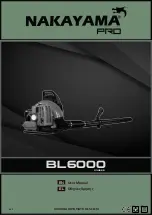
WORKING TECHNIQUES
English
–
23
1154580-38 Rev.1 2011-12-05
The log is lying on the ground. There is little risk of the
chain jamming or the object splitting. However there is a
risk that the chain will touch the ground when you finish
the cut. (63)
Cut all the way through the log from above. Avoid letting
the chain touch the ground as you finish the cut. Maintain
full throttle but be prepared for what might happen. (64)
If it is possible (can you turn the log?) stop cutting about
2/3 of the way through the log.
Turn the log and finish the cut from the opposite side. (65)
The log is supported at one end. There is a high risk
that it will split. (58)
Start by cutting from below (about 1/3 of the way through).
Finish by cutting from above so that the two cuts meet.
(66)
The log is supported at both ends. There is a high risk
that the chain will jam. (59)
Start by cutting from above (about 1/3 of the way through).
Finish by cutting from below so that the two cuts meet.
(67)
Tree felling technique
Safe distance
The safe distance between a tree that is to be felled and
anyone else working nearby is at least 2 1/2 tree lengths.
Make sure that no-one else is in this ”risk zone” before or
during felling. (68)
Felling direction
The aim is to fell the tree in a position where you can limb
and cross-cut the log as easily as possible. You want it to
fall in a location where you can stand and move about
safely.
Once you have decided which way you want the tree to fall
you must judge which way the tree would fall naturally.
Several factors affect this:
•
Lean of the tree
•
Bend
•
Wind direction
•
Arrangement of branches
•
Weight of snow
•
Obstacles within the reach of the tree: for example,
other trees, power lines, roads and buildings.
•
Look for signs of damage and rot in the stem, this
makes it more probably that the tree will break and
start to fall before you expect it to.
You may find you are forced to let the tree fall in its natural
direction because it is impossible or dangerous to try to
make it fall in the direction you first intended.
Another very important factor, which does not affect the
felling direction but does affect your safety, is to make sure
the tree has no damaged or dead branches that might
break off and hit you during felling.
The main point to avoid is letting the tree fall onto another
tree. It is very dangerous to remove a trapped tree and
there is high accident risk. See instructions under the
heading Freeing a tree that has fallen badly. (69)
Clearing the trunk and preparing your retreat
Delimb the stem up to shoulder height. It is safer to work
from the top down and to have the tree between you and
the saw. (70)
Remove any undergrowth from the base of the tree and
check the area for obstacles (stones, branches, holes,
etc.) so that you have a clear path of retreat when the tree
starts to fall. Your path of retreat should be roughly 135
degrees away from the intended felling direction. (71)
1
Danger zone
2
Retreat path
3
Felling direction
Felling
Felling is done using three cuts. First you make the
directional cuts, which consist of the top cut and the
bottom cut, then you finish with the felling cut. By placing
these cuts correctly you can control the felling direction
very accurately.
Directional cuts
To make the directional cut you begin with the top cut. Aim
using to the saw’s felling direction mark (1) toward a goal
further forward in the terrain, where you would like the tree
to fall (2). Stand on the right-hand side of the tree, behind
the saw, and cut with a pull stroke.
Next make the bottom cut so that it finishes exactly at the
end of the top cut. (72)
The directional cuts should run 1/4 of the diameter
through the trunk and the angle between the top cut and
bottom cut should be 45
°
.
The line where the two cuts meet is called the directional
cut line. This line should be perfectly horizontal and at
right angles (90
°
) to the chosen felling direction. (73)
Felling cut
The felling cut is made from the opposite side of the tree
and it must be perfectly horizontal. Stand on the left side
of the tree and cut on the pull stroke.
IMPORTANT! It takes a lot of experience to fell a tree.
Inexperienced users of chain saws should not fell trees.
Do not attempt any task that you feel unsure of!
IMPORTANT! During critical felling operations, hearing
protectors should be lifted immediately when sawing is
completed so that sounds and warning signals can be
heard.
!
WARNING! Unless you have special
training we advise you not to fell trees
with a diameter larger than the bar length
of your saw!
















































